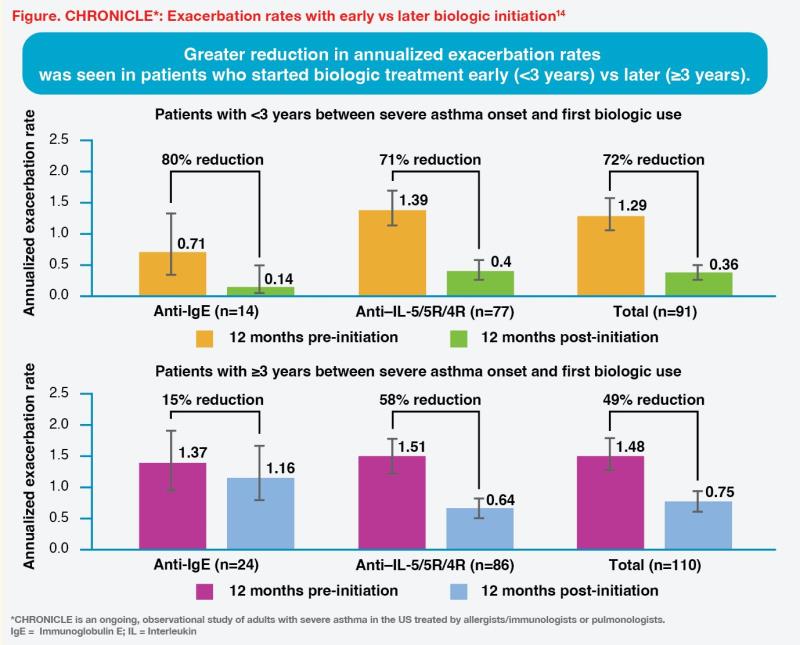Mepolizumab cuts exacerbation, hospitalization and corticosteroids exposure in a young patient with severe Th2 asthma and marginal BEC level





Presentation, history and prior treatment
A 36-year-old Caucasian overweight female banker with increasingly severe allergic and asthma symptoms presented to our clinic in late October 2024, after consulting multiple doctors in the US and UK for many years. She had been a smoker since the age of 24 years and switched to vaping 18 months before presentation and was advised to stop smoking. Since a young age, she had frequently experienced shortness of breath on minimal exertion, sports-induced asthma and respiratory tract infections.
Despite being on triple combination maintenance therapy with inhaled corticosteroid (ICS)/long-acting β-agonist (LABA)/long-acting muscarinic antagonist (LAMA), she had four episodes of severe asthma exacerbations with three requiring hospitalization in the past year. She received short-term oral corticosteroids (OCS) 20–40 mg daily for about 10 days per exacerbation episode. (Table)

The patient had a history of sinusitis and recurrent rhinoconjunctivitis managed with antihistamines and corticosteroid nasal sprays, as well as various allergies (eg, house dust mites, tree and grass pollen) that were poorly controlled despite 5 years of immunotherapy. She was also allergic to erythromycin, cefuroxime and levofloxacin. The exacerbation episodes were possibly triggered by work stress on top of poorly controlled underlying allergies and asthma.
Chest X-ray report was unremarkable. Blood tests were positive for Mycoplasma pneumoniae immunoglobulin (Ig) G antibodies, confirming intercurrent infection history, but negative for bacteria on pneumoniae multiplex polymerase chain reaction panel test. Blood eosinophil count (BEC) at various time points ranged between 150 and 300 cells/μL, depending on her clinical condition. Her IgE level was not elevated, and vitamin D level was slightly low.
Based on her phenotypic manifestations and blood test results, the patient was diagnosed as having adult-onset T-helper 2 (Th2) cough variant asthma, with bronchial hyperresponsiveness and allergic rhinitis.
Anti–IL-5 treatment and response
In addition to suboptimal responses to conventional asthma and allergy treatments, concern regarding cumulative corticosteroid doses and long-term adverse effects (such as increased body weight, and mood swings that required treatment with alprazolam) called for a corticosteroid-sparing therapy.
In November 2024, after in-depth discussion with the patient, treatment with mepolizumab began. Although mepolizumab is shown to be generally safe and well tolerated, the patient was admitted for inpatient administration of the first dose as a precautionary measure for close monitoring of possible adverse reactions, given her history of allergies and as she was not feeling well at that time. Her slight vitamin D deficiency was concurrently treated to further reduce her susceptibility to upper respiratory tract infections and exacerbations.
After the first dose of mepolizumab, the patient reported immediate symptom improvement. She was then discharged from hospital with monthly subcutaneous (SC) mepolizumab injection pens. Her frequency of clinic visits decreased from twice monthly to once every 2–3 months. Notably, the frequency of moderate-to-severe exacerbations decreased from four episodes per year to zero. (Table)
Her cough, rhinosinusitis and mood swings also improved, and she has not required any OCS since starting mepolizumab. Her inhaled treatment de-escalated from triple therapy to dual therapy with ICS/LABA.
The patient tolerated mepolizumab well and did not report any adverse effects. Last seen in May 2025, she had stable disease, with well-controlled symptoms maintained on mepolizumab 100 mg Q4W. She reported marked improvement in quality of life (QoL). (Table)
Discussion
At the time of presentation, our patient had poorly controlled symptoms and frequent exacerbations requiring hospitalization despite receiving Global Initiative for Asthma (GINA) Global Strategy for Asthma Management and Prevention Step 4–5 recommended treatment.1
While she was responsive to OCS, cumulative corticosteroid doses (estimated at a minimum of 2 g over the last 20 years) and the associated long-term adverse effects are serious concerns, given the potential for further exposure if her condition remains refractory. A fundamental change in management strategy to an OCS-sparing and effective agent was therefore necessary.
Mepolizumab, an anti–interleukin (IL)-5, was chosen for our biologic-naïve patient based on her eosinophilic/type 2 (T2) inflammation phenotypical symptoms with only moderately high BEC (150–300 cells/μL) – a profile similar to the T4 cluster of a subset of patients in the U-BIOPRED (Unbiased Biomarkers for the Prediction of Respiratory Disease Outcomes) study. My positive experience with mepolizumab, and its effectiveness and safety profile also contributed to choosing this agent.2
This decision was supported by the latest GINA guidelines, which recommend biologics targeting T2 inflammation as add-on therapy (if available/affordable) after establishing severe asthma phenotype in the final management step (Step 5). Severe asthma is defined in the GINA guidelines as poor symptom control and frequent exacerbations despite maximal optimized high-dose ICS/LABA treatment and management of contributory factors, or that worsens when high-dose treatment is decreased. GINA has also acknowledged that use of mepolizumab reduces risk of severe disease exacerbation irrespective of baseline fractional exhaled nitric oxide (FeNO), improves QoL, and reduces need for OCS.1
Mepolizumab directly inhibits IL-5, a key cytokine generated in T2 inflammation. This reduces the number of eosinophils and other inflammatory cells such as neutrophils, basophils, mast cells and fibroblasts in circulation and tissue sites. IL-5 inhibition also modifies T cells and IL-C2 cells, which, together with positive effects on epithelial cells within the respiratory system, curbs the underlying disease processes in severe Th2 asthma, paving the way for restored immune balance and epithelial integrity, reduced mucus plugging and reversal of airway remodelling, thereby reducing exacerbations as well as the need for OCS.3-11
Post-hoc subanalyses of the REALITI-A study, which assessed mepolizumab’s real-world effectiveness in 822 patients with overlapping allergic and eosinophilic phenotypes, confirmed that SC mepolizumab 100 mg Q4W reduces clinically significant exacerbations irrespective of baseline BEC, FeNO, IgE or prior omalizumab use.12,13
Early use of biologics not only reduces exacerbations, but also helps preserve lung health.14,15 In the real-world observational CHRONICLE study in US adults with severe asthma, initiating biologics <3 years from severe asthma onset led to numerically greater reductions in annualized exacerbations (72 vs 49 percent) than starting after ≥3 years.14 (Figure)

The post-hoc analysis of the real-world REDES study assessed the effectiveness and safety of SC mepolizumab 100 mg Q4W for 12 months in 318 patients with severe asthma in Spain. At baseline, patients with shorter vs longer asthma duration had significantly better lung function. In addition, at 12 months after starting mepolizumab, the proportion of patients achieving prebronchodilator forced expiratory volume in 1 second (FEV1) normalization (≥80 percent) was higher among those with shorter disease duration. These results support early use of mepolizumab after asthma diagnosis to potentially help preserve lung function.15
Our patient’s repeated relocations led to fragmented care and prevented earlier use of mepolizumab, which could have reduced exacerbations and improved her lung function.
Conclusion
Patient selection for mepolizumab treatment is not always clear-cut. While biomarker levels are a useful guide, it is important not to solely rely on them (in instances where they fall near or below standard treatment thresholds) to start treatment with biologics. Clinical decisions should instead be made taking into consideration patients’ history and clinical symptoms, such as those of the case described, where mepolizumab proved effective despite BEC not being exceedingly high.
Trial results and real-world data show that mepolizumab reduces asthma exacerbations, improves QoL, minimizes the need for long-term OCS, and has a well-tolerated safety profile.